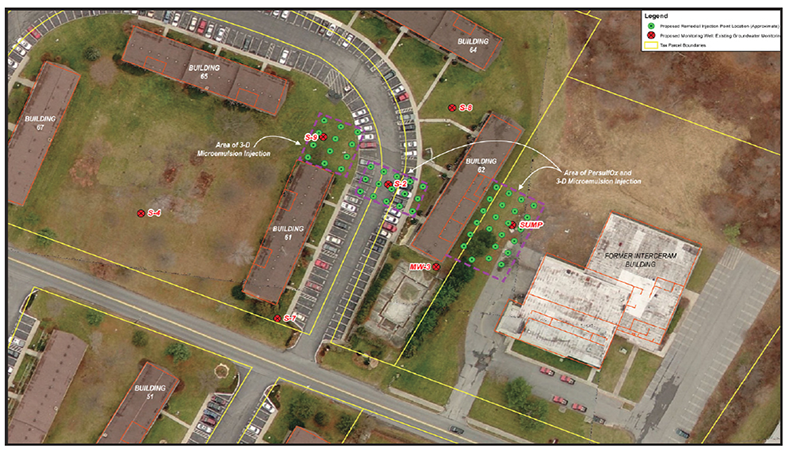Former Service Station Treated on Native American Reservation Land
Combined Remedies Used to Remediate BTEX Contamination
Project Highlights
- Enhanced Aerobic Bioremediation and In Situ Chemical Oxidation used to treat high BTEX levels on-site
- Previous remediation activities included soil excavation but contamination persisted
- One application area located in lot used for beef cattle on reservation land and special approvals were required
- Project was state-funded by Pollution Liability Insurance Agency (PILA) of Washington but regulated by Region 10 EPA resulting in extensive coordination between both agencies
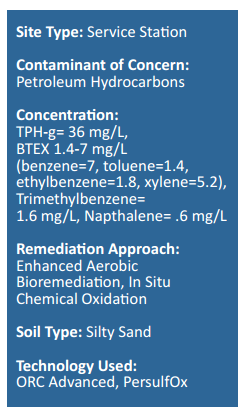
Project Summary
This Wapato, Washington site was a former gas station with historical releases dating back to at least 1995. It is located on a Native American Reservation so the site is regulated through Region 10 of the EPA.
The initial remedial activities consisted of excavation of source area soil but contamination remained. Considering the persistent contamination, the goal of the site was to reduce the remaining concentrations to meet regulatory goals.
Remediation Approach
A combied remedies strategy was devised for this site, including in situ treatment in three separate areas. Two areas were treated with both PersulfOx® and ORC® Advanced.
The third area was an empty lot that was used for ranging beef cattle. The client had concerns about how the treatment might affect the cattle, so only ORC Advanced was applied to this area because it is both insoluable and non-toxic. Because the entire site was located on reservation land it required special approvals by the tribal irrigation office before the injections could occur. A total area of 4,100-square-feet was treated for high levels of BTEX. Monitoring is ongoing.
Technology Description
ORC Advanced is a proprietary formulation of food-grade, calcium oxy-hydroxide that produces a controlled-release of molecular oxygen for periods of up to 12 months upon hydration.
PersulfOx is a sodium persulfate-based chemical oxidation technology which destroys both hydrocarbon and chlorinated solvent-type contaminants in the subsurface. PersulfOx contains a built-in catalyst which activates the persulfate component and generates contaminant-destroying free radicals without the need for the addition of a separate activator
PersulfOx® ISCO Remediation Reduces BTEX F1 & F2 Concentrations at Alberta Municipal Affairs Site
ISCO Solution Results in Cost Savings and Treatment Area Reduction at Former Service Station
Project Highlights
- In Situ Chemical Oxidation (ISCO) used as a cost-effective alternative to excavation remediation methods
- In Situ treatment using direct push resulted in reduction in treatment area
- ISCO solution met time and budget goals
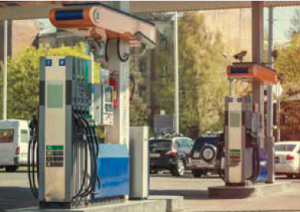
Project Summary
BTEX contaminated soil was found at an Alberta Municipal Affairs (AMA) site. The former service station located in Central Alberta, Canada had left a petroleum leak creating a smear zone with F1 and F2 concentrations at the source of the plume. Since the AMA site had limited funding and time constraints, a persulfate-based ISCO solution using PersulfOx was recommended to significantly reduce high petroleum concentrations in the soil and groundwater. This site marked the first time the engineering firm working with REGENESIS had employed an ISCO solution, having used excavation remediation methods as their recommended approach in the past. An expedited remediation plan was created and included multiple rounds of PersulfOx injections to treat the site.
Remediation Approach
PersulfOx was applied in seven existing monitoring wells. Working with the engineering firm, using direct-push injection of PersulfOx, REGENESIS strategically focused the application around two of the existing monitoring wells. Due to the saturated soil type and an increased risk for surfacing, precise application-volume monitoring was required. After the first round of two applications was completed, overall contaminant concentrations decreased.
REGENESIS Solution Applied
PersulfOx is a sodium persulfate-based chemical oxidation technology which destroys both hydrocarbon and chlorinated solvent-type contaminants in the subsurface. PersulfOx contains a built-in catalyst which activates the persulfate component and generates contaminant-destroying free radicals without the need for the addition of a separate activator.
Results
The REGENESIS ISCO plan incorporating direct-push injections of PersulOx significantly reduced the level of BTEX contaminant concentrations following the first round of application. The PersulfOx solution effectively addressed the plume in the saturated smear zone, while meeting the goals of the project, as well as the client’s time and budget constraints.
Former Paint Manufacturing Facility Treated for MIBK, BTEX
RRS Implements Cost-Effective, Turn-Key Remediation in Low-Permeability Soils
Project Highlights
- Soil and groundwater impacted with both BTEX and MIBK.
- Low-permeability soil was of a concern to the client, however very little surfacing was witnessed post-injection.
- Regenesis Remediation Services (RRS) finished the project in half the time and nearly half the cost of competing firms.
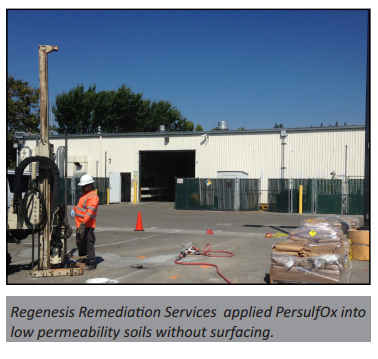
Project Summary
Site operations at a former paint manufacturing facility in Northern California caused soil and groundwater to be impacted with MIBK and BTEX compounds. The site was under an order for clean-up through the regional water quality board and the treatment was designed to use in situ chemical oxidation (ISCO) to reduce contaminant mass in the source area before transitioning to MNA.
Remediation Approach
Comprised of what the consultant described as “San Francisco Bay Muds” or essentially clay soil with sand stringers, the site had challenging geologic conditions. At first, the client was apprehensive about the ability to inject PersulfOx® into the tight soils without surfacing. However, a turn-key approach was devised during the design of this project, with an emphasis on minimizing product application costs and addressing any possible surfacing issues. A total of 29,644 pounds of PersulfOx was applied by RRS in two applications, through a total of 58 directpush points and 2 injection wells at the site. The product was applied at a 20% solution for a total injection volume of 15,691 gallons.
The injections were completed in half the time and nearly half the cost of what other injection contractor firms proposed. The capabilities of the RRS team, trailer and ability to manifold and inject into four points at one time resulted in significant time and cost savings for the client. Monitoring is ongoing.
Technology Description
PersulfOx is a sodium persulfate-based chemical oxidation technology which destroys both hydrocarbon and chlorinated solventtype contaminants in the subsurface. PersulfOx contains a built-in catalyst which activates the persulfate component and generates contaminant-destroying free radicals without the need for the addition of a separate activator.
RRS is a dedicated team of scientists and engineers whose primary function is to provide environmental engineering and consulting firms with specialized groundwater and soil remediation planning, design, verification and application services.
RegenOx® Injected Into Frozen Permafrost at Alaska Site
Seasonal Access and Remote Location Require Unique Remediation Plan at Service Station
Project Highlights
- Sensitive ecosystem and limited seasonal accessibility required a unique remediation plan design.
- RegenOx® injected into frozen permafrost.
- Overall remediation plan requires three applications while site is accessible in summer months.

Project Summary
Located in Deadhorse, Alaska, this service station site was contaminated through multiple releases from the diesel and gasoline tanks. When this lease site was originally bid, it was required to be constructed with a minimum of 5 feet of gravel on the pads to protect the tundra. This lease requirement remains today.
The remote location on the North Slope of Alaska made it challenging to design, plan, and implement a remediation plan considering the temperatures were just above freezing. The area can only be accessed seasonally for monitoring/application and shipping products to the site proved to be a challenge. Located in a very sensitive native ecosystem (tundra/permafrost), in situ chemical oxidation (ISCO) was chosen as the remediation approach to avoid enlarging the plume.
Overall treatment goal for the project is to reduce hydrocarbon concentrations in approximately 365 cubic yards of source area soil to below cleanup levels. Treatment will be conducted in multiple phases and this project summary will summarize steps taken within the first year to address one-third of the exceedance area.
Remediation Approach
Surface soil to down to one-foot below ground surface was removed and stockpiled before subsurface soil from (1-5 feet below ground surface) was treated via in situ soil mixing using RegenOx®. Based on the effectiveness of Year 1 treatment; the plan is to use the same treatment method on remaining soil in subsequent years.
For the 125 cubic yards (or 1/3 of contaminated soil at the site), a total of 3,430 pounds of RegenOx (2,500 pounds of RegenOx Part A and 930 pounds of RegenOx Part B) were applied to treat BTEX, TPH, and naphthalene concentrations. Due to the sensitive and remote nature of the site, the application was staggered and the methodology was ultimately modified to prevent oversaturation and reduce the risk of plume migration. The Part B was mixed with a small amount of water and then applied and mechanically mixed thoroughly into the treatment area, followed by the Part A being applied dry and then well-mixed over the same area.
Technology Description
RegenOx is an advanced chemical oxidation technology that destroys contaminants through powerful, yet controlled chemical reactions and not through biological means. This product maximizes in situ performance while using a solid alkaline oxidant that employs a sodium percarbonate complex with a multi-part catalytic formula.
REGENESIS Remediation Services – LNAPL Treated with Combined Remedies
Active Michigan Service Stated Remediated Through Use of PetroCleanze® and ORC® Advanced
RRS was contracted to remediate a residual LNAPL and dissolved phase petroleum plume from historic gasoline and diesel fuel releases at an active service station. PetroCleanze® was chosen as the primary remediation technology to facilitate recovery of residual LNAPL and chemically oxidize contaminants without negatively impacting sensitive infrastructure. ORC® Advanced was also applied with the final PetroCleanze application event and in a downgradient plume cut off barrier to promote the enhanced aerobic bioremediation of the dissolved-phase petroleum hydrocarbons.
Eight injection/extraction wells and 28 direct-push injection points were used to apply the remediation reagents in the silty sand aquifer and smear zone over three application/injection events. Vacuum extraction was conducted between PetroCleanze applications to recover residual free phase petroleum hydrocarbons liberated from the soils. Reagent distribution monitoring confirmed PetroCleanze was dispersed across the targeted source area during each application event.
Prior to the first PetroCleanze application event, no measurable free product was observed on this site since 2006. Less than twenty-four hours after the first PetroCleanze application event, LNAPL was observed in four of the eight wells in the source area at quantities up to three inches thick.
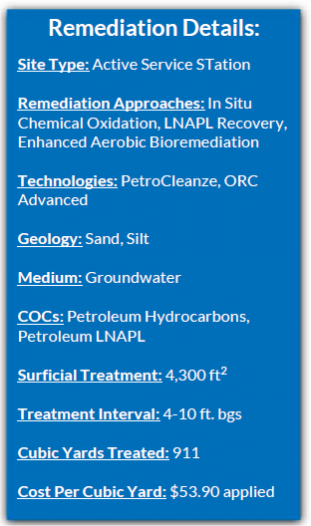
Not more than a sheen was observed in any wells on site after the third injection event. A total of 2,160 pounds of PetroCleanze and 1,120 pounds of ORC Advanced were injected.
Regenesis Remediation Services™ – LNAPL Plume Treated at Iowa Service Station
PetroCleanze and ORC Advanced Remediate Historic Petroleum Hydrocarbon Contamination
RRS was contracted to remediate a dissolved phase LNAPL petroleum hydrocarbon plume petroleum fuel releases at a former service station PetroCleanze® was chosen as the primary remediation technology to facilitate recovery of residual LNAPL and chemically oxidize contaminants without negatively impacting sensitive infrastructure. ORC Advanced was also applied with the final PetroCleanze application enhanced aerobic bioremediation of hydrocarbons.
Eighteen direct-push injection points were used to apply the reagents in the silty sand aquifer and application events. Three vacuum extraction conducted after each PetroCleanze application to recover residual free phase petroleum hydrocarbons liberated from the soils.
Reagent distribution monitoring confirmed PetroCleanze was dispersed across the targeted source area during events.
Direct-push injection points were advanced to 15 feet below ground surface where bottom-up injections were performed to 5 feet. A total of 4,470 pounds of PetroCleanze and 720 pounds were injected.
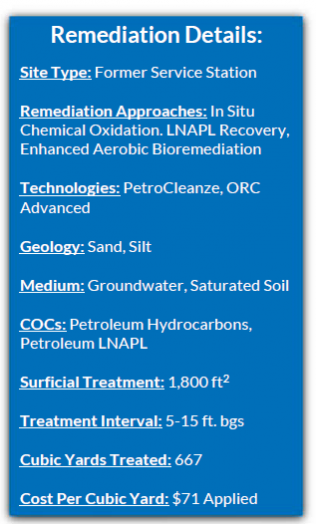
Regenesis Remediation Services™ – TCE Plume Treated with Combined Remedies
Wisconsin Manufacturing Facility Remediated with RegenOx®, 3-D Microemulsion ®
A stainless steel tube manufacturing facility and their environmental consultant, Symbiont, selected Regenesis as a team member to assist in the design and implementation an in situ chemical oxidation and ERD remediation plan. The goal was to reduce trichloroethene (TCE) in source area groundwater over a 1.5 acre site from as high as 110,000ug/L to less than 10,000 ug/L using RegenOx, then transition to ERD. RegenOx® was applied through injection wells over three to five applications from 11/2007 to 6/2008. Five month later, ERD was started using 3-D Microemulsion® in this sandy surficial aquifer.
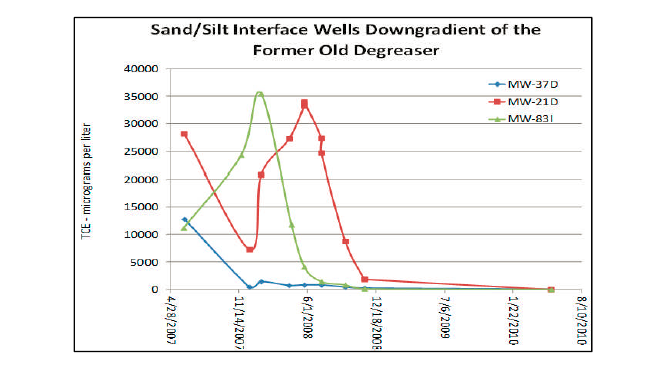

Successful Performance-Based Remediation Program at DOD Facility
Former Air National Guard Base in Ohio Treated for High TCE Levels
Project Highlights
- Highly technical design included three different remediation approaches requiring 105 injection points
- 87,000 lbs of PersulfOx successfully applied while not impeding operations at active military site
- Treatment area included injections through an 18-inch-thick concrete tarmac
- State-of-the-art mixing and application equipment allowed for optimal reagent injection in sub-zero temperatures
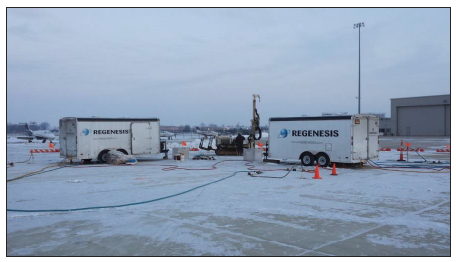
Project Summary
REGENESIS Remediation Services (RRS) partnered with an environmental consulting firm on a performance-based contract for a Department of Defense site remediation project in Ohio. A TCE plume was detected below the Air National Guard base with concentrations as high as 14,000 ppb. REGENESIS designed the remediation program and performed turn-key application services, including on-site treatment of excavated soils, in situ chemical oxidation through galleries within the subsurface, and injection points across the 16,000-square-foot plume. All operations were accomplished within an active military installation and included injecting through an 18-inch-thick tarmac into a sandy aquifer.
Injections took place during the winter months in below freezing conditions. RRS used heaters around the water supply and utilized their heated trailers to prevent the product and water from freezing. Over the course of two injection events, over 80,000 pounds of PersulfOx® Catalyzed Persulfate was applied to the contaminated area. Three application areas called for different remediation approaches with three horizontal injection galleries below a former excavation, nine injection wells down 27 feet below ground surface and a grid of 105 injection points around a hot spot source area. An additional 7,000 pounds of PersulfOx was applied to the bottom of the excavation site to treat the impacted soil. Application monitoring data collected throughout the field work documented the area of influence impacted by each application point.
Technology Description
PersulfOx is a sodium persulfate-based chemical oxidation technology which destroys both hydrocarbon and chlorinated solvent-type contaminants in the subsurface. PersulfOx contains a built-in catalyst which activates the persulfate component and generates contaminant-destroying free radicals without the need for the addition of a separate activator.
Results
Employing a highly technical remediation strategy, RRS successfully applied PersulfOx to three different areas using targeted remediation approaches resulting in performance-based remediation goals sequentially being met and ensuring a high level of client satisfaction.
REGENESIS® Achieves MCL Cleanup Goals at New York Manufacturing Facility
cVOC Contamination Successfully Treated Using PersulfOx® and 3-D Microemulsion®
Project Highlights
- 99% reduction of target compounds achieved on-site
- TCE levels reduced from 8,000 ug/L to <5 ug/L to meet site goals
- Integrated remediation approach using PersulfOx® and 3-D Microemulsion® (3DME)

Project Summary
A manufacturing facility in New York was contaminated with high levels of chlorinated solvents. TCE levels were as high as 8,000 ug/L. A combined remedies approach was established to address the migrating plume. The goal of the application design was to reduce cVOCs in the source area, reduce potential for vapor intrusion and address any cVOCs that may migrate into the area downgradient of the manufacturing facility.
An integrated remediation strategy using PersulfOx and 3DME was implemented on-site. Two PersulfOx applications were completed. Results from the In Situ Chemical Oxidation (ISCO) treated area showed >99% reduction of target compounds. A total of 11,600 pounds of PersulfOx was applied on-site. 3DME was applied to enhance anaerobic biodegradation in downgradient locations and within the PersulfOx-treated area. A total of 8,400 pounds of 3DME was applied. While groundwater contamination in the ISCO treated area was reduced to clean-up standards, the goal of the 3DME application was strictly preventative. The client wished to address any potential plume migration from any cVOCs that may be present beneath the building.
Technology Description
PersulfOx is a sodium persulfate-based chemical oxidation technology which destroys both hydrocarbon and chlorinated solvent-type contaminants in the subsurface. PersulfOx contains a built-in catalyst which activates the persulfate component and generates contaminant-destroying free radicals without the need for the addition of a separate activator.
3-D Microemulsion is an engineered electron donor material that offers a novel 3-stage electron donor release profile, pH neutral chemistry and is delivered on-site as a factory-emulsified product.
Results
The use of PersulfOx safely and effectively reduced TCE levels to regulatory standards providing a 99% reduction of cVOC’s achieved on-site. In addition, the integration of 3DME as a precautionary safety measure addressed the potential for plume migration that was thought to be present.
ISCO/ERD Treat PCE Contamination at Indiana Dry Cleaner
Remediation Plan Addresses Concentrations Below Facility and Downgradient
Project Highlights
- PersulfOx utilized subslab near the source to inhibit vapor issues within the building.
- Combined remediation plan addressed impacts both below the building and downgradient of the facility.
- PCE contamination was nearly depleted and TCE levels below 10 ppb were observed.
- The site is currently being monitored to demonstrate plume stability with approximately 3-4 more monitoring events prior to site closure.

Project Summary
A release of PCE from a former dry cleaning operation in Indianapolis resulted in groundwater contamination below the facility and downgradient. Contamination impacts were also observed in shallow fill below the concrete slab. Along with the groundwater/soil contamination, vapor intrusion was also detected within the facility and adjacent spaces in the strip mall. A combination of enhanced reductive dechlorination (ERD) and in situ chemical oxidation (ISCO) was used for remedial action. Analytical results obtained indicate nearly complete reduction of PCE and less than 10 ppb of TCE in all wells. Per the recent sampling event, VC concentrations have dropped in all wells. Monitoring is ongoing.
Remediation Approach
PersulfOx® Catalyzed Persulfate was injected below the floor slab of the dry cleaner to inhibit vapor production within the facility and adjacent spaces. 3-D Microemulsion® and Bio-Dechlor INNOCULUM® Plus were injected into the uppermost water-bearing area below the dry cleaner and into two areas downgradient on either side of the building. Supplemental ERD injections were applied in two areas approximately 9 months after the initial injection to address minor sand stringers that were contributing to continued contamination impacts. The supplemental injection resulted in immediate elimination of PCE/TCE and a rapid production of VC. The site is currently being monitored to demonstrate plume stability with approximately 3-4 more monitoring events prior to site closure.
Technology Description
PersulfOx is a sodium persulfate-based chemical oxidation technology which destroys both hydrocarbon and chlorinated solvent-type contaminants in the subsurface. PersulfOx contains a built-in catalyst which activates the persulfate component and generates contaminant-destroying free radicals without the need for the addition of a separate activator.
3-D Microemulsion is an engineered electron donor material that offers a novel 3-stage electron donor release profile, pH neutral chemistry and is delivered on-site as a factory-emulsified product.
Bio-Dechlor INOCULUM Plus is an enriched natural microbial consortium containing species of Dehalococcoides sp. (DHC). This microbial consortium has since been enriched to increase its ability to rapidly dechlorinate contaminants during in situ bioremediation processes.

 Americas
Americas Europe
Europe Français
Français Deutsch
Deutsch Italiano
Italiano Español
Español
